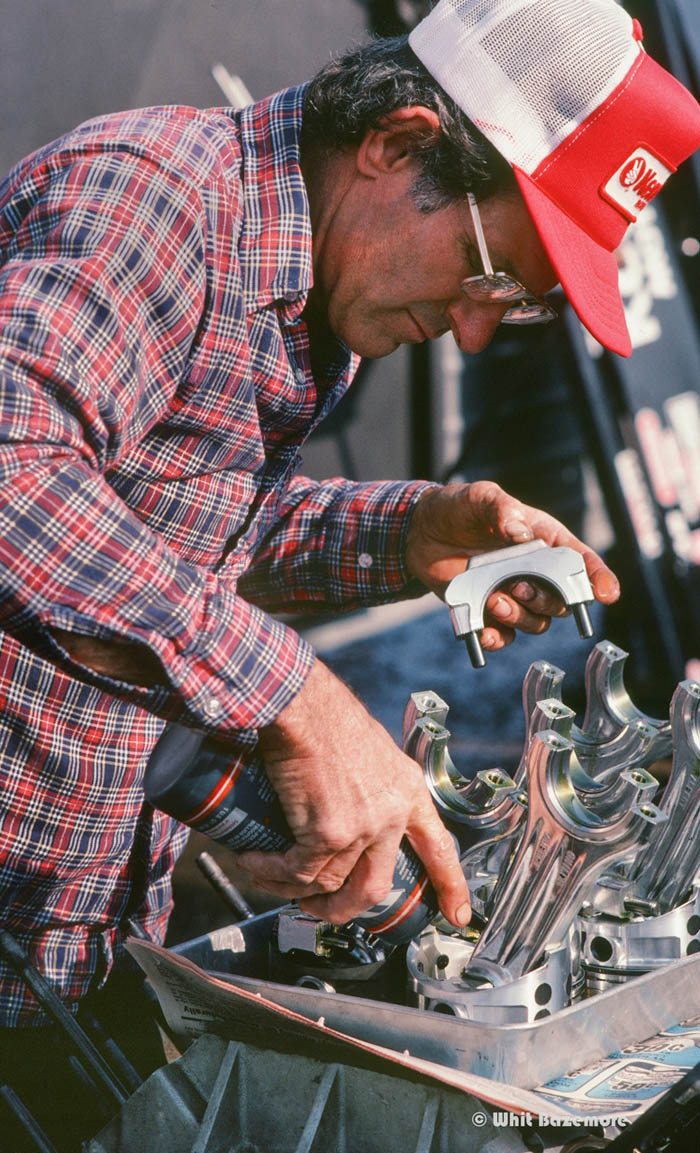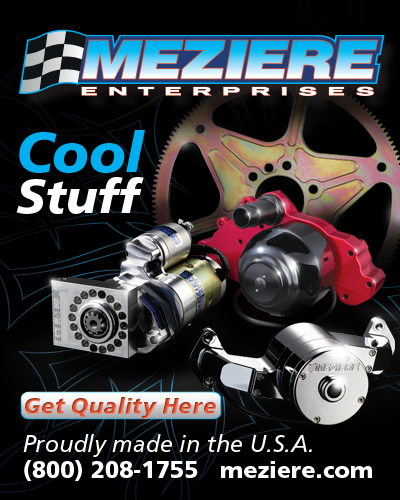GARLITS BELIEVES NITRO CAN RETURN TO 1320, CREW CHIEFS NOT IN FAVOR
 With Top Fuel and Funny Car entries each falling short of their 16-car eliminator field at five of 14 NHRA national events this season, the question ‘why?’ has been in play all year long.
With Top Fuel and Funny Car entries each falling short of their 16-car eliminator field at five of 14 NHRA national events this season, the question ‘why?’ has been in play all year long.
Top Fuel giant “Big Daddy” Don Garlits believes that slowing those nitromethane-fueled divisions down would help make racing less expensive, which is another way of saying it would be more affordable to those interested in giving it a shot. He also believes that the moves he has in mind would allow NHRA nitro racing to return to a 1,320-foot distance rather than the current 1,000-foot course — a distance that’s been the standard since the death of Funny Car competitor Scott Kalitta at Englishtown, N.J., in 2008.
Two current Top Fuel crew chiefs, Mark Oswald and Mike Kloeber, agree that the ideas Garlits has in mind for reducing the cars’ speed — smaller superchargers and fuel pumps — would achieve the desired effect. But they’re adamantly against changing the status quo for numerous reasons.
Garlits broached the subject last week while talking about his current bid to break the 200-mph barrier with his battery-powered dragster; a pursuit that fell short at 189, a run that broke his existing record. (The chase for 200 was sidelined by breakage, according to the Fort Lauderdale Sun-Sentinel.)
Garlits eased into the conversation about curtailing Top Fuel performance as an avenue for returning to quarter-mile racing.
“Top Fuel’s a lot more dangerous” than the battery-powered dragster, Garlits said. “They’re dealing with an explosive fuel; as explosive as dynamite. Not just sitting in the car, but once you put it in the combustion chamber and capture it and manage it. And then you put a spark in there, it makes 11,500 horsepower with eight cylinders.
“You’ve seen the explosions on TV. It’s a miracle they don’t kill somebody with it, it’s so violent. And I love it, but I never ran it the way they run it today. We always had limitations because we used engines that were basically car engines, and they could only take so much punishment and they fell apart. They were your limiting factors, like a safety valve. You could step up the blower boost, and you could step up the nitromethane percentage and the engine just blew to bits.
“Today the technology has allowed them to have such strong parts that they can get away with it for a few moments. The race only lasts 3.7 seconds, and you and I both know that’s not much of a race. And then the expense!”
The solution, he said, is to reduce the size of the superchargers, which would limit the amount of air the engine could convert into horsepower, and reduce the size of the fuel pump to limit the rate that nitro is being fed into the fire.
“Everything else could be the same,” Garlits said. “You know why they don’t do that? It’s because the explosions would disappear. Those parts are so good that once you reduced the horsepower from 11,500 to 7,500 to 8,000, which would give you about 300 miles an hour in the quarter, the explosions would be non-existent and the parts would never get hurt. You’d run a whole meet on one engine.
“And television, for openers, would disappear. And for the second thing, a lot of other guys would get into drag racing, like me, that don’t like to blow up stuff, and we would overcome all these rich billionaires that are controlling the sport now. A regular little team could run as good as anybody because it ain’t a question of who can blow up the most parts and spend the most money.”
Oswald won the NHRA and IHRA championships in Funny Car in 1984, and he was the driver who broke Garlits’ Top Fuel record of 5.63 seconds that stood for more than seven years. Those exploits, and three NHRA Top Fuel titles as the crew chief for driver Antron Brown, earned Oswald induction into the Garlits’ International Drag Racing Hall of Fame in 2016.
But Oswald and Garlits don’t see eye to eye on the subject to today’s nitro scene. He believes that cutting back on the performance of the Top Fuel and Funny car vehicles is a bad idea for multiple reasons.
“Personally, I wouldn’t go to see it. Drag racing’s an acceleration contest,” Oswald said. “What is a 300 mile-an-hour car in a quarter-mile? It’s a glorified alcohol car. People will not watch that; I won’t watch that. Don’t you go for the noise and the acceleration? I do. To me, it’s the noise and the acceleration that the people like.”
 That was evident last weekend in Denver, when Steve Torrence’s CAPCO dragster inhaled enough of the thin, mile-high air to generate a 330-mph blast.
That was evident last weekend in Denver, when Steve Torrence’s CAPCO dragster inhaled enough of the thin, mile-high air to generate a 330-mph blast.
“The fans went wild,” said Kloeber, who tuned Clay Millican’s Parts Plus ride to a runner-up finish. “They love to see the cars go fast. That’s what, regardless of the type of fan — new fan, old fan, diehard fan — everybody enjoys the speed part of it. It pays on the time slip in the elapsed time, the win light, but it doesn’t pay anything on the speed. But it’s the speed that’s entertaining to the fans.”
Oswald said he doesn’t understand the attraction to the prospect of slower quarter-mile racing at select NHRA events, calling it “wimpy in comparison” to the current product.
“This is just my opinion. I appreciate people that have a different opinion, but it’s certainly not mine,” he said. “A 300 mile-an-hour car in a quarter-mile is not very entertaining, that’s what I’m saying.”
The trump to any argument at any distance, Oswald said, is safety. “It’s not just a 320-foot difference; it’s 320 feet that you’re not accelerating,” he said. “It’s a huge safety thing what 1,000 feet did for us — probably one of the smartest things we’ve ever done in racing. And now these guys want to undo that?”
Besides, Oswald said, the notion of returning to a 1,320-foot distance is fundamentally a waste of time.
Why?
Because he doesn’t believe the racers will allow it. And what could they do about it? Well, a boycott would be a possibility. That’s the avenue nitro Funny Car teams took at the 1981 NHRA Cajun Nationals over a purse dispute.
“Pretty much all of the racers are going to mutiny on that, and it won’t happen,” Oswald said. “I don’t know any crew chief or driver that is for that. There might be a couple; I’m not saying that they’re not, but the rest of us are pretty much appalled by the thought of it.
“It’s irresponsible, is what it is. I’m very adamant about this. I was the one yelling the loudest to go to 1,000 feet when Scott got killed because it just makes sense.
“Basically, they want to (return to quarter-mile racing at select facilities) probably because they think it’s going to put some fans in the seats. I think they’re wrong. And it’s going to really hurt the racers. What, are you going to have to have two complete combinations? Think about that. They’re struggling to get a car count now, and they’re going to do that? I don’t see it.”
And adding to that is the opinion of Oswald’s team owner: “Don Schumacher said, ‘Well, my cars aren’t going there — and if they do, they’re shutting off at 1,000 feet,’ “Oswald said.
Kloeber noted that “the cars have not gotten that much safer, we’re just living in a more realistic world. We don’t use up that last 320 feet trying to have a little more fun — because that’s what it boils down to because the only guy that enjoys that is the guy behind the wheel. I’m standing there watching and thinking, ‘I hope it’s not hurt, I hope nothing happens.’ It’s exciting for the fans, but the rest of us on my side of the fence are all holding their breath.
“We’re using up a lot of that safety margin if we do go back to the quarter-mile. … I think everybody has the best level of confidence right now that they’ve ever had in terms of safety and performance as a combination. I think we have a pretty good recipe and I’m reluctant to go there myself. I’m pretty content racing 1,000 feet, going 330 miles an hour on a good day. I have no desire to go back to a quarter-mile.”
Kloeber added that if racers, track promoters, NHRA and others collectively agree that quarter-mile drag racing is what’s best for the sport, he “would certainly go along with it.”
But, he noted, “I’m not running around saying, ‘We oughta go back to quarter-mile’ because I don’t think it’s a great idea.”
Get the @competitionplus Mobile APP to get your drag racing news quick and easy. - https://t.co/HsiKEmdZXO pic.twitter.com/qpgtrHqnpr
— Competition Plus (@competitionplus) January 4, 2019






































